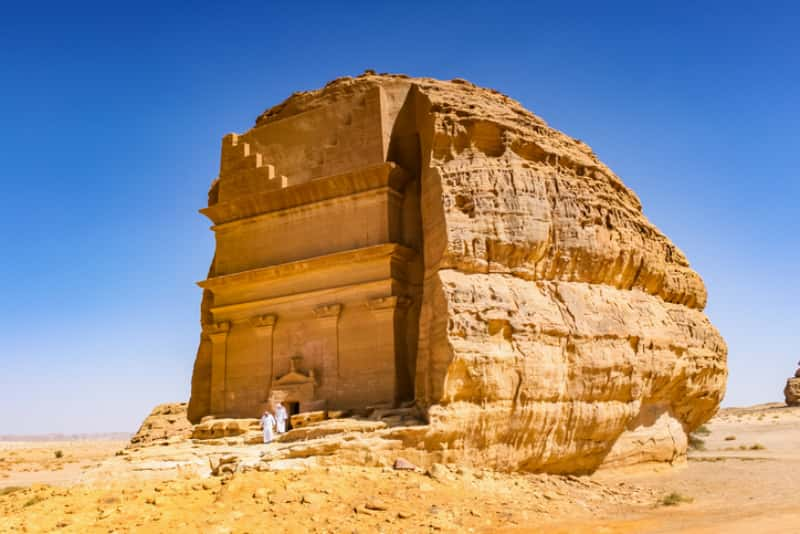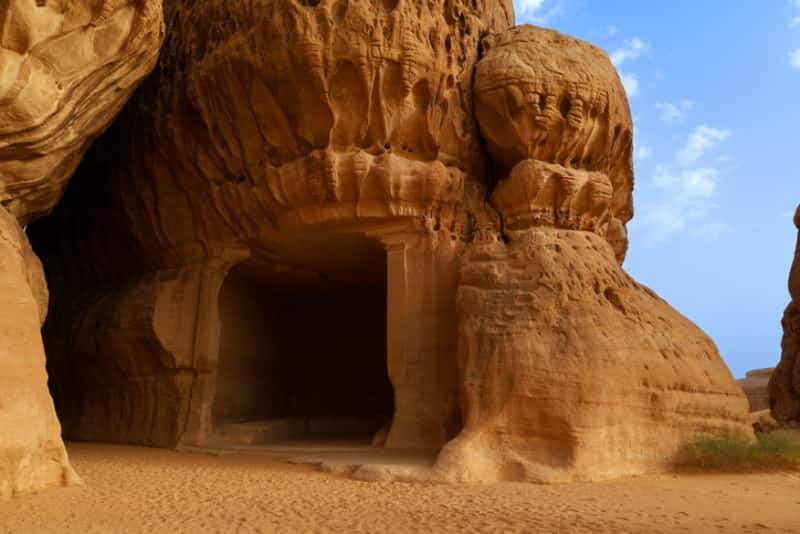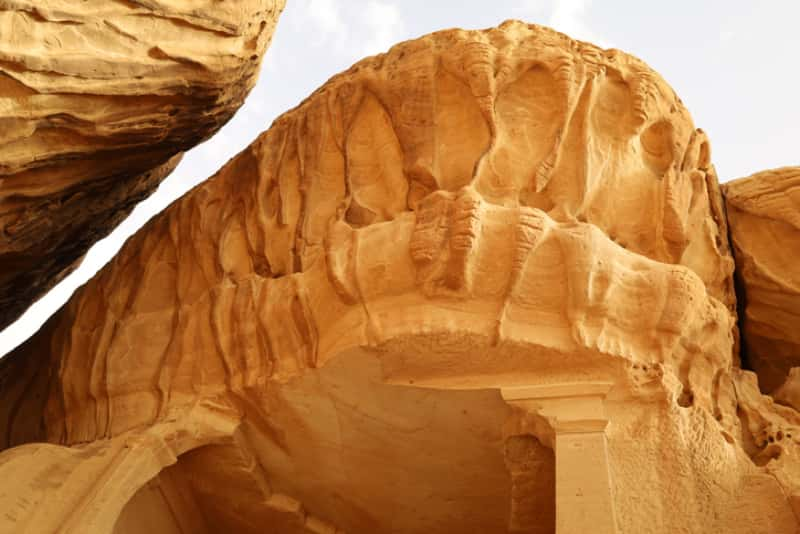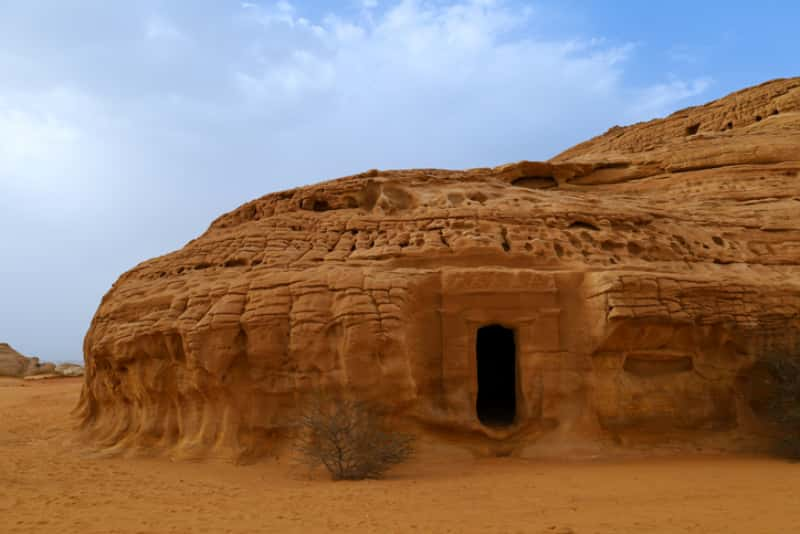Qasr al-Farid, aptly named "the Lonely Castle," commands attention from its solitary position within the Madâin Sâlih archaeological site in northern Saudi Arabia. Contrary to what its name suggests, this magnificent structure functions not as a castle but as an unfinished tomb dating back to the 1st century CE, constructed by the affluent Nabataean civilization. Among the more than 100 monumental tombs dotting the Hegra landscape, Qasr al-Farid stands as the largest, boasting an impressive four-story façade that reaches 72 feet skyward.
Visitors to this isolated monument witness an extraordinary example of Nabataean craftsmanship that has weathered two millennia of desert conditions. Scholars believe the tomb was commissioned for Hayyan bin Koza, a prominent citizen of the Kingdom of Lihyan, with its exceptional scale reflecting the elevated social position of its intended occupant. The monument now draws roughly 400,000 visitors yearly, though access remains restricted to its exterior. Qasr al-Farid achieved global prominence upon its designation as a UNESCO World Heritage site in 2008, subsequently featuring in international events such as the 2020 Dakar World Rally. For centuries, this archaeological treasure remained closed to outside exploration; only recently has the Hegra site welcomed international visitors, enabling scholars to uncover fascinating new insights about the enigmatic Nabataean civilization.
The ancient Nabataeans began as nomadic desert traders who flourished between the first century BCE and the first century CE, carving an enduring legacy across the Arabian Peninsula through their architectural brilliance. These masterful merchants dominated crucial trade routes, amassing extraordinary wealth that enabled their creation of monumental structures like Qasr al-Farid.
Nabataean craftsmen erected Qasr al-Farid during the first century CE at the zenith of their civilization's prosperity. Their control over profitable trade routes linking the Mediterranean world to southern Arabia generated tremendous wealth, financing their ambitious architectural endeavors. Qasr al-Farid stands as a powerful testimony to both their engineering capabilities and cultural traditions. While commonly referred to as a castle, this imposing structure served a much different purpose—a grandiose tomb designed to commemorate an esteemed individual within Nabataean society.
Qasr al-Farid captivates modern observers with its distinctive construction methodology. Nabataean artisans utilized an unusual top-down carving technique, working directly into the sandstone outcrop. Evidence of this approach appears in the varying finishes—exquisitely detailed at the upper portions but progressively rougher toward the base—indicating the project remained unfinished. These incomplete sections offer archaeologists a privileged glimpse into ancient Nabataean building techniques that would typically remain concealed beneath finished surfaces.
Qasr al-Farid distinguishes itself from other Madain Saleh tombs through its profound isolation, standing approximately 10km from the main burial complex. This physical remoteness inspired its evocative name, "The Lonely Castle." Among 111 monumental tombs distributed throughout Hegra, Qasr al-Farid's solitary positioning renders it uniquely remarkable. Though 94 other tombs display decorative elements, none match the isolated magnificence of this structure.
Scholars continue debating the rationale behind this unusual placement. Was this location selected deliberately to honor someone of extraordinary significance? Perhaps geological factors determined this site selection, or social considerations influenced its distancing from communal burial grounds. Whatever the explanation, this isolation has significantly enhanced its iconic status among Saudi Arabia's archaeological treasures.
Historical records suggest Qasr al-Farid was commissioned as the eternal resting place for Hayyan bin Koza, a distinguished citizen from the Kingdom of Lihyan. The façade's upper sections, particularly above the grand entrance, feature ancient inscriptions rendered in Lihyanite, Thamudic, and Nabataean scripts. Scholars have interpreted these inscriptions variously—some readings suggest "Lihyan son of Kuzza took it," while alternative translations propose "For Hayyan son of Kuzza and his descendants".
The incomplete state of Qasr al-Farid prompts numerous questions about its abandonment. What circumstances prevented the completion of such an ambitious monument? Political upheavals, economic difficulties, or perhaps the death of its commissioners might explain the work's cessation. These lingering questions enhance the mystique surrounding this magnificent structure, transforming it from merely an architectural achievement into an enduring historical enigma.

Qasr al-Farid stands as a magnificent exemplar of ancient rock engineering, showcasing the architectural brilliance that established the Nabataeans as master builders throughout the ancient world. This colossal tomb offers scholars precious insights into construction methodologies that have survived more than two millennia of desert winds and seasonal rains.
Nabataean artisans excelled at transforming natural sandstone formations into elaborate architectural marvels. Rather than assembling structures from quarried blocks, they sculpted directly into existing rock outcroppings at Qasr al-Farid Hegra. This remarkable monument exists among 131 monumental rock-cut tombs scattered across 13.4 kilometers throughout the region.
Nabataean architecture distinguishes itself through its syncretic character. Their designs incorporated stylistic elements borrowed from Assyrian, Phoenician, Egyptian, and Hellenistic Alexandria influences, seamlessly blended with their native artistic traditions. This cultural amalgamation produced a distinctive architectural vocabulary evident in Qasr al-Farid's ornate façade with its four prominent pilasters—a feature setting it apart from neighboring tombs that typically display only two.
The incomplete state of Al Farid Tomb constitutes one of its most captivating aspects. Roughly one-third of the lower portion remains unfinished, exhibiting coarse chisel marks instead of the refined detailing visible in the upper sections.
This partially completed state presents archaeologists with an extraordinary opportunity. While fully completed Nabataean structures conceal their construction techniques beneath polished surfaces, Qasr al-Farid preserves tangible evidence of the creation process itself. The tomb rises 72 feet skyward, its most intricate features adorning the upper portions, including the distinctive stepped crown reminiscent of Petra's Treasury.
Rough chisel marks along the base serve as conclusive evidence that Nabataean craftsmen employed a top-down approach when creating these monuments. Archaeologists studying the progressively coarser workmanship toward the lower sections have determined that artisans initiated their work at the summit and methodically progressed downward.
The unfinished sections additionally reveal the preliminary stages of the carving process. Craftsmen first established the general form, then refined details beginning from the highest point. This methodical strategy demanded exceptional planning, as any error proved irreversible once stone was removed. The abandoned work effectively captures the construction process mid-execution, providing researchers an invaluable glimpse into ancient building techniques that would otherwise remain theoretical.

Qasr al-Farid represents but one magnificent jewel within the archaeological treasure chest of Hegra. This remarkable tomb exists within an expansive historical tapestry that illuminates the true breadth of Nabataean ingenuity and cultural achievement.
Among the 111 monumental tombs scattered throughout Hegra, Qasr al-Farid reigns as the most renowned. Ninety-four of these tombs showcase decorative elements meticulously carved into the sandstone surface. The site achieved historical significance in 2008 when it became Saudi Arabia's first entry on the prestigious UNESCO World Heritage List.
Hegra's tombs occupy four separate necropolis zones: Jabal al-Mahjar to the north, Qasr al-walad, Area C in the southeast, and Jabal al-Khuraymat southwest. Jabal al-Khuraymat stands as the most extensive of these areas, housing 48 distinct tombs distributed among various rock formations. Throughout these necropolis zones, each tomb's dimensions and decorative elaboration directly corresponds to the social prominence of its occupant.
While Qasr al-Farid occupies its isolated position, the majority of Hegra's tombs cluster together in groups. The Qasr al-Bint collection contains 31 tombs constructed between the years 0 and 58 CE. These structures feature distinctive ornamental motifs, including fearsome monster masks, eagle figures, and human visages.
The architectural signature distinguishing Qasr al-Farid lies in its façade composition. Unlike all other tomb façades with their two pilasters, Qasr al-Farid uniquely incorporates four, positioned at each corner, plus two additional ones centrally placed. Further distinguishing this structure, archaeological investigations have uncovered no evidence of burial chambers within Qasr al-Farid, unlike the completed Qasr al-Bint tombs.
Beyond their monumental tombs, the Nabataeans displayed remarkable hydraulic mastery. Approximately 130 wells dot the western and northwestern sections of Hegra. These engineering achievements, measuring 4-7 meters in diameter, were carved directly into bedrock and accessed groundwater just 20 meters beneath the surface.
This advanced water management enabled a sophisticated agricultural system. Archaeological excavations have uncovered evidence of tiered oasis farming with vegetation organized on three levels—date palms occupying the highest tier, fruit trees in the middle stratum, and cereals and legumes at ground level. The archaeological record further reveals how Nabataeans engineered elaborate drainage channels that simultaneously protected their carved monuments from water damage while efficiently capturing rainfall in storage cisterns.

Madain Saleh etched its name in history books in 2008 as Saudi Arabia's first UNESCO World Heritage site, thrusting Qasr al-Farid into international prominence. This prestigious recognition transformed the ancient Nabataean tomb from a relatively obscure archaeological curiosity into a cultural treasure acknowledged for its universal significance.
The UNESCO designation catalyzed a remarkable surge in visitor numbers, with Qasr al-Farid now welcoming approximately 400,000 visitors yearly. Standing as Saudi Arabia's most magnificent example of Nabataean architectural achievement outside Petra, the lonely castle functions simultaneously as a cultural landmark and tourism centerpiece. Global events have further amplified its visibility, notably the 2020 Dakar World Rally, which traversed the area surrounding this iconic structure. Archaeological teams from around the world now conduct extensive research at Hegra, unearthing new revelations about Nabataean civilization that remained concealed for centuries.
Qasr al-Farid has emerged as the focal point of AlUla's dynamic cultural calendar. The winter season, spanning December through March, features four significant festivals collectively known as "Al Ula Moments"—the Al Ula Wellness Festival, Arts Festival, Al Ula Skies, and Winter at Tantora. These celebrations incorporate captivating performances such as "Path of Poets" alongside the extraordinary Desert X installation, an outdoor art exhibition presenting works by fifteen Saudi and international artists exploring themes of "mirage and oasis."
Conservation initiatives for the Lonely Castle align perfectly with Saudi Arabia's Vision 2030, which seeks economic diversification through sustainable tourism development. The Saudi government has established a substantial $4 billion tourism development fund while setting ambitious targets—projecting tourism's contribution to GDP will reach 10% by 2030, more than triple its current 3%. Local communities increasingly participate in both preservation projects and tourism planning, creating valuable economic opportunities through revitalized traditional crafts and cultural expressions. Future development envisions luxury accommodations, including the Sharaan resort conceptualized by renowned architect Jean Nouvel, alongside sustained archaeological research and conservation efforts safeguarding this irreplaceable heritage treasure for subsequent generations.
Qasr al-Farid endures as powerful evidence of the Nabataean civilization's engineering brilliance and cultural affluence. Despite remaining forever incomplete, this magnificent tomb has paradoxically lived up to its name—"The Lonely Castle"—through its solitary stance among Hegra's 111 monumental structures. Archaeologists treasure the unfinished lower portions for the rare window they provide into ancient construction methodologies, clearly demonstrating the top-down carving technique that brought this sandstone wonder into existence.
Centuries passed with this architectural marvel hidden from global awareness until it finally received international acknowledgment as an integral component of Saudi Arabia's first UNESCO World Heritage site. Once accessible to merely a privileged few, this sandstone masterpiece now welcomes hundreds of thousands of annual visitors. The structure's unique four-pilaster design and elaborate façade explain why Qasr al-Farid continues to reign as the crowning achievement of Hegra's archaeological treasures.
Qasr al-Farid transcends its identity as merely an ancient tomb. Its importance stretches beyond archaeology into contemporary Saudi cultural identity and economic prospects. The lingering questions surrounding its unfinished condition and isolated location remain unanswered, yet these very mysteries heighten the monument's fascination. As Saudi Arabia advances its tourism framework around Hegra, Qasr al-Farid will undoubtedly persist as a fundamental element of regional heritage—a solitary sentinel bridging ancient achievements with future aspirations.
Q1. How old is Qasr al-Farid?
Qasr al-Farid dates back to the 1st century CE, making it approximately 2,000 years old. It was constructed by the Nabataean civilization during their peak period of prosperity.
Q2. Why is Qasr al-Farid called "The Lonely Castle"?
Despite its name, Qasr al-Farid is not actually a castle but a tomb. It's called "The Lonely Castle" because it stands in isolation, about 10km away from the main tomb complex at Hegra, unlike most other Nabataean tombs which were built in groups.
Q3. What makes Qasr al-Farid unique among Nabataean tombs?
Qasr al-Farid is distinctive for its four-pilaster facade, whereas other Nabataean tombs typically feature only two pilasters. It's also the largest of over 100 monumental tombs in the area, standing 72 feet tall.
Q4. Why is Qasr al-Farid unfinished?
The exact reason for its incomplete state remains a mystery. The unfinished lower portion provides valuable insights into Nabataean construction techniques, revealing that they worked from top to bottom when carving these structures.
Q5. Is Qasr al-Farid open to visitors?
Yes, Qasr al-Farid is open to visitors as part of the Hegra archeological site. Since its UNESCO World Heritage designation in 2008, it has been attracting around 400,000 visitors annually. However, exploration is limited to the exterior of the structure.
Discover Qasr al-Farid, Hegra's "Lonely Castle," a majestic Nabataean tomb. Explore this UNESCO site on your Saudi trips and step into ancient history!

Find Related Tours


© Copyright 2024 Go Saudi Arabia Trips. All Rights Reserved.